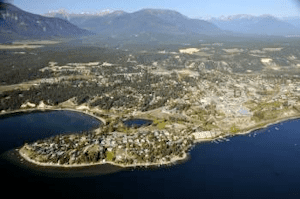Country Canada Region East Kootenay Elevation 859 m (2,818 ft) Population 2,955 (2011) | Incorporated 1951 Local time Tuesday 5:05 PM | |
 | ||
Time zone Mountain Standard (MST) (UTC-7) Weather 7°C, Wind SE at 10 km/h, 76% Humidity Points of interest James Chabot Provincial, Kinsmen Beach, Pynelogs Cultural Centre, Windermere Valley Museum | ||
Kinsmen beach invermere
Invermere is a community in eastern British Columbia, Canada, near the border of Alberta. With its growing permanent population of almost 4,000 (including Athalmer and Wilmer), swelling to near 40,000 on summer weekends, it is the hub of the Columbia Valley between Golden in the north, and Cranbrook to the south. Invermere sits on the northwest shore of Lake Windermere and is a popular summer destination for visitors and second home owners from Calgary.
Contents
- Kinsmen beach invermere
- Map of Invermere BC Canada
- Geography
- Climate
- Sports and recreation
- Media
- Notable people
- References
Map of Invermere, BC, Canada
Geography
Invermere is located 14 kilometres (8.7 mi) south of Radium, and 104 kilometres (65 mi) south of Golden and 102 kilometres (63 mi) from the Trans-Canada Highway. Invermere is also 37 kilometres (23 mi) north of Fairmont Hot Springs, 60 kilometres (37 mi) north of Canal Flats, 128 kilometres (80 mi) north of Fort Steele, 130 kilometres (81 mi) north of Kimberley, and 144 kilometres (89 mi) north of the hub of Cranbrook and the Crowsnest Highway. Invermere is situated within the Columbia River Wetlands, North America's largest intact wetland and a Ramsar-designated site. Located in the Rocky Mountain Trench, Invermere is 17.5 kilometres (10.9 mi) from Kootenay National Park, and is near the Purcell Wilderness Conservancy.
Climate
Invermere's climate is characterized by warm summers and cool winters. The Rocky Mountains to the east shield Invermere from the Arctic air in winter, although extreme cold spells do occur on occasion. Spring arrives earlier than on the prairies to the east of the Rocky Mountains. Although warm, summers are variable, with weather alternating between hot, dry spells and cool, showery periods.
Sports and recreation
The Columbia Valley Rockies play in Invermere. Former New York Islanders and University of Denver goaltender Wade Dubielewicz was born in Invermere.
Panorama Mountain Village lies about 30 minutes west. Fairmont Hot Springs Resort ski area lies 25 minutes south. Kimberley Alpine Resort is about 1 hour south in Kimberley. Kicking Horse Mountain Resort is about 1.5 hours north of Invermere in Golden, British Columbia
Invermere is a major centre for golf.
The Invermere Airport is home to the non-profit Canadian Rockies Soaring Club. The club is active during the summer months, when it welcomes dozens of student pilots and private owners. The Invermere Soaring Centre is a separate commercial operation which provides aerotowing services and glider rides to the general public.
The local area is also a popular destination for other non-motorized forms of flying including hang-gliding and paragliding. There are designated launch sites at nearby Mount Swansea.
The Valley is host to the biggest outdoor bonspiel in Canada every January. The spiel is held on the frozen Windermere Lake. The curling club is also host to many leagues and bonspiels throughout the season.
Hot springs are numerous in the area, with the major developed ones being Fairmont and Radium Hot Springs; the latter is located inside Kootenay National Park.
Less developed 'wilderness' hot springs can be found in the southern Columbia Valley, in Whiteswan Lake Provincial Park. Lussier Hot Springs is located 74 kilometres (46 mi) south of Invermere and can be accessed from the Whiteswan Forestry Road. Ram Creek Warm Springs, a lesser visited and cooler natural spring, can also be accessed along the same route.
Media
Invermere is home to two newspapers, the Columbia Valley Pioneer, founded in 2004, and the Invermere Valley Echo, founded in 1956. The papers serve the Columbia Valley region, from Spillimacheen in the north to Canal Flats in the south.
